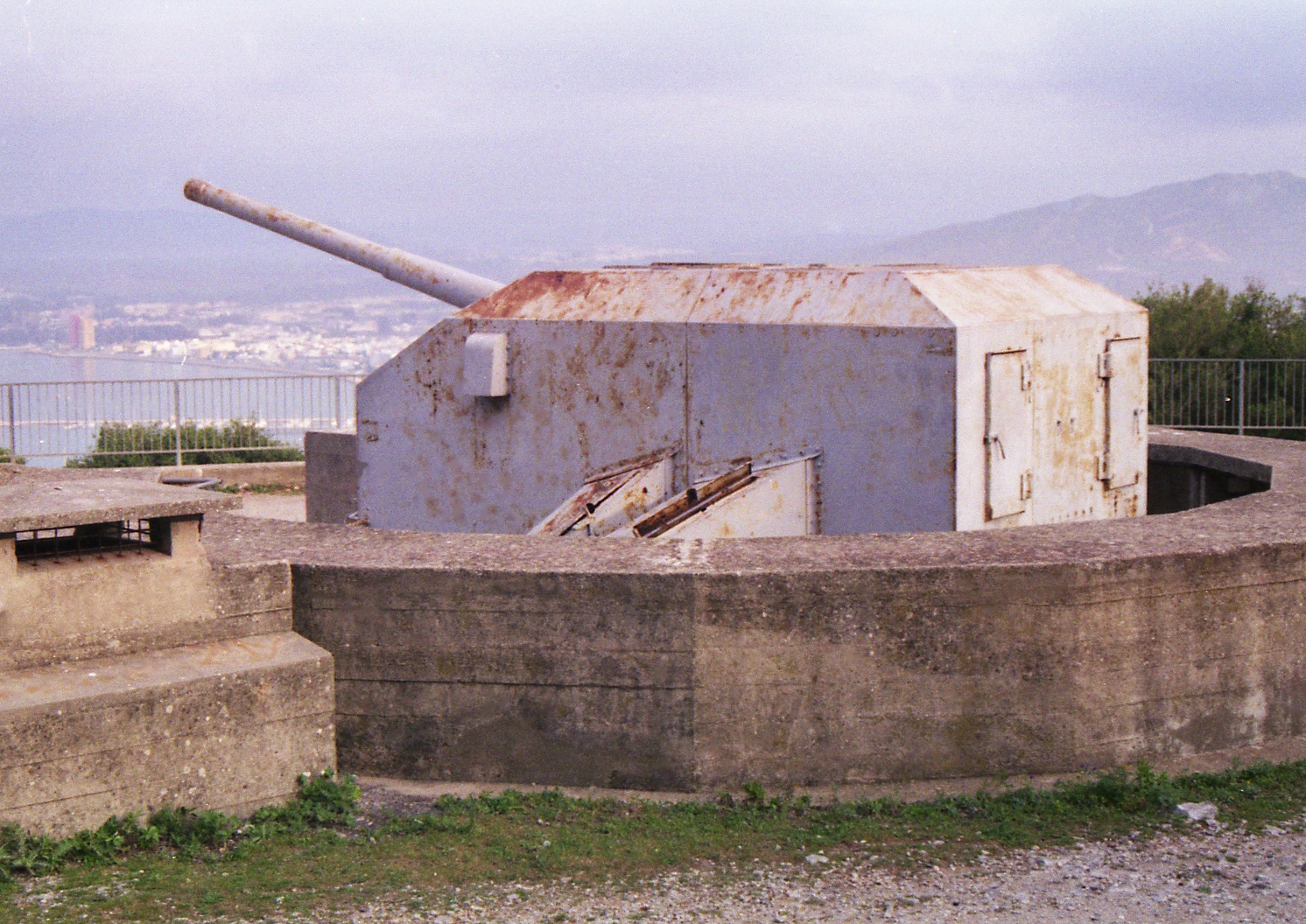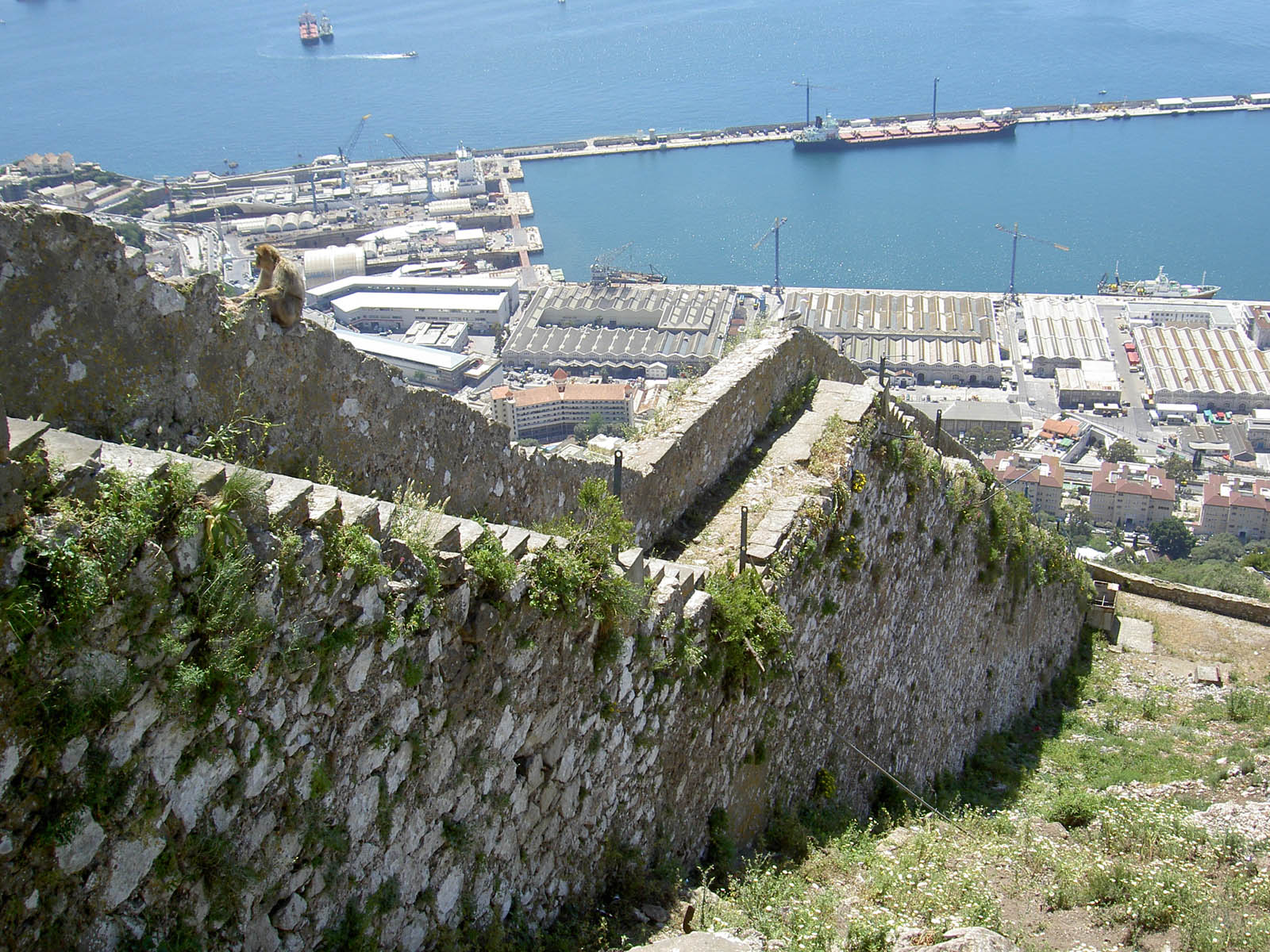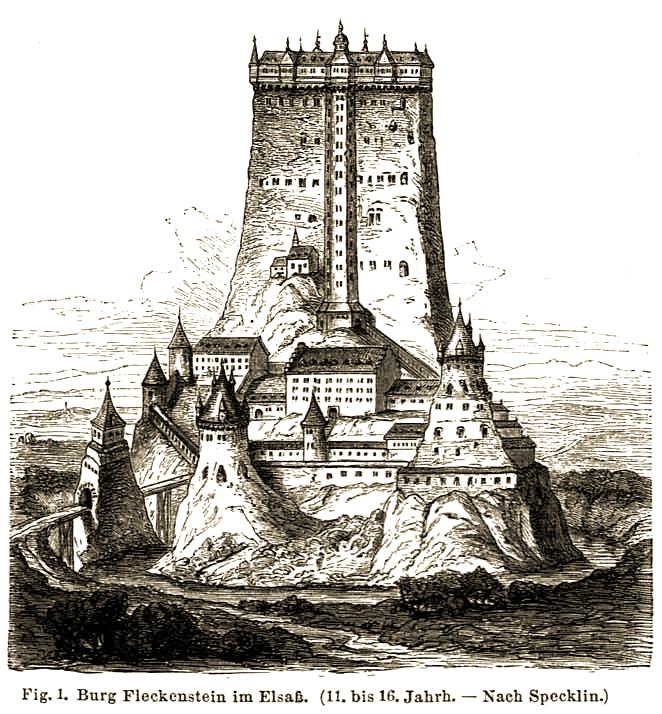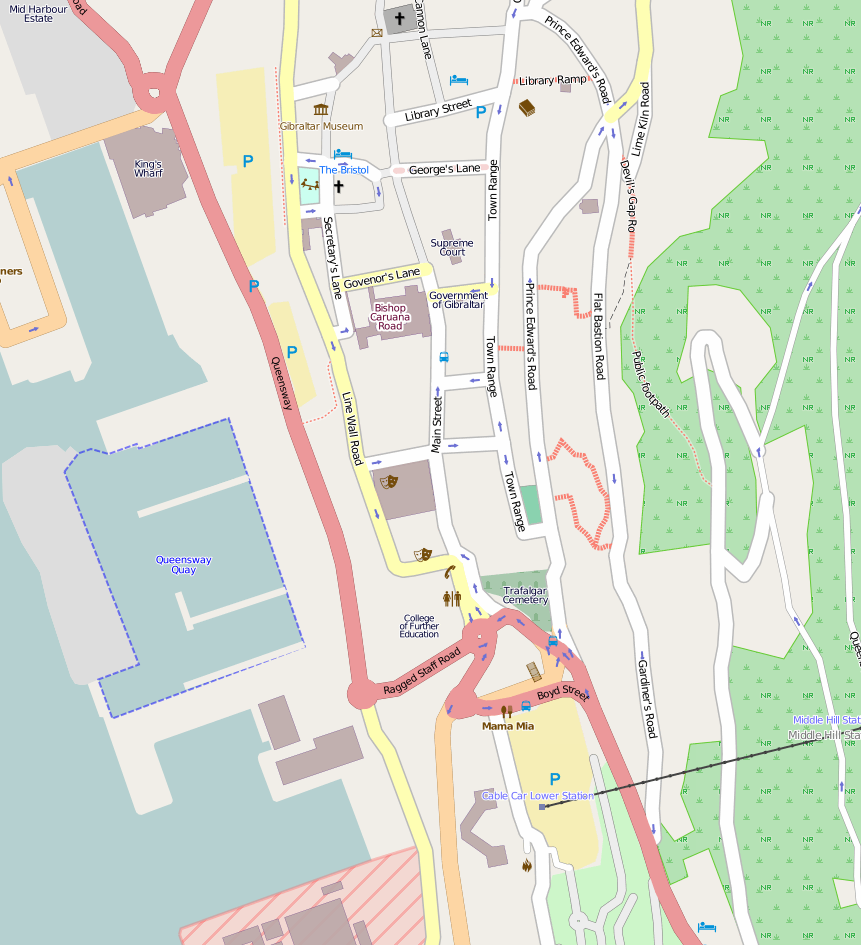|
South Bastion, Gibraltar
The South Bastion was part of the fortifications of Gibraltar, protecting the western base of the Charles V Wall. It was originally built by Spanish military engineers, later improved by the British. The South Bastion stands at the south end of the Line Wall Curtain which defends the town from attack from the Bay of Gibraltar. Another curtain wall runs east from the bastion to the base of a precipice. This wall is pierced by the Southport Gates, guarded by the South Bastion and the Flat Bastion on either side. Early structures The Milanese military engineer Giovanni Battista Calvi visited Gibraltar in 1557 and drew plans for two defensive positions to the south of the town, where the South Bastion and Flat Bastion now stand, connected by a new curtain wall. Calvi was ill, and did not stay to carry out the planned works. It may have been another Italian, Amodeo Agostino, who died in 1571 who built the original bastions. Another source says the bastion that was incorporated into ... [...More Info...] [...Related Items...] OR: [Wikipedia] [Google] [Baidu] |
Fortifications Of Gibraltar
The Gibraltar peninsula, located at the far southern end of Iberia, has great strategic importance as a result of its position by the Strait of Gibraltar where the Mediterranean Sea meets the Atlantic Ocean. It has repeatedly been contested between European and North African powers and has endured fourteen sieges since it was first settled in the 11th century. The peninsula's occupants – Moors, Spanish, and British – have built successive layers of fortifications and defences including walls, bastions, casemates, gun batteries, magazines, tunnels and galleries. At their peak in 1865, the fortifications housed around 681 guns mounted in 110 batteries and positions, guarding all land and sea approaches to Gibraltar. Hughes & Migos, p. 91 The fortifications continued to be in military use until as late as the 1970s and by the time tunnelling ceased in the late 1960s, over of galleries had been dug in an area of only . Gibraltar's fortifications are clustered in three main a ... [...More Info...] [...Related Items...] OR: [Wikipedia] [Google] [Baidu] |
Giovanni Battista Calvi
Giovanni Battista Calvi (also known as Giovan Battista Calvi, Gianbattista Calvi and/or Juan Bautista Calvi) was an Italian military engineer at the service of the Spanish Monarchy during the 16th century. Early career Despite popular belief that Calvi was born in Sardinia, he was actually born in Lombardy in the early 16th century. Prior to working for the Spanish Monarchy he worked as a civil engineer in Rome, under the direction of Antonio da Sangallo the Younger, on the façade of Palazzo Farnese. He later worked in Siena, at the time also under Spanish sovereignty, with Diego Hurtado de Mendoza as governor of the garrison. In 1552, he was sought out by Philip II (then only a Prince) to fortify the Spanish coasts and the frontier with France in the Roussillon. Reputation Calvi was the first engineer to provide comprehensive reports on the status of the defensive projects of Spain and the Spanish North-African possessions. Besides his works in the Franco-Spanish frontie ... [...More Info...] [...Related Items...] OR: [Wikipedia] [Google] [Baidu] |
John Doubleday (sculptor)
John Doubleday (born 9 October 1947) is a British sculptor and painter. His work includes statues of political leaders such as Nelson Mandela and Golda Meir as well as cultural icons such as The Beatles, Sherlock Holmes and Laurel and Hardy. Doubleday was born in 1947 in Langford, near Maldon, Essex and studied sculpture at Goldsmiths College. In 2014, he unveiled a statue of Herbert George Columbine which is the United Kingdom's only statue of a named army private. See also * Statue of Charlie Chaplin, London * Statue of Sherlock Holmes, London A statue of Sherlock Holmes by the sculptor John Doubleday stands near the supposed site of 221B Baker Street, the fictional detective's address in London. Unveiled on 23 September 1999, the sculpture was funded by the Abbey National building s ... References Sources * External links Official website {{DEFAULTSORT:Doubleday, John 20th-century British sculptors Modern sculptors 21st-century British sculptors 1947 birt ... [...More Info...] [...Related Items...] OR: [Wikipedia] [Google] [Baidu] |
Battle Of Trafalgar
The Battle of Trafalgar (21 October 1805) was a naval engagement between the British Royal Navy and the combined fleets of the French and Spanish Navies during the War of the Third Coalition (August–December 1805) of the Napoleonic Wars (1803–1815). As part of Napoleon's plans to invade England, the French and Spanish fleets combined to take control of the English Channel and provide the Grande Armée safe passage. The allied fleet, under the command of the French admiral, Pierre-Charles Villeneuve, sailed from the port of Cádiz in the south of Spain on 18 October 1805. They encountered the British fleet under Lord Nelson, recently assembled to meet this threat, in the Atlantic Ocean along the southwest coast of Spain, off Cape Trafalgar. Nelson was outnumbered, with 27 British ships of the line to 33 allied ships including the largest warship in either fleet, the Spanish ''Santísima Trinidad''. To address this imbalance, Nelson sailed his fleet directly at the allied ba ... [...More Info...] [...Related Items...] OR: [Wikipedia] [Google] [Baidu] |
Gibraltar College
The Gibraltar College is a school in the British Overseas Territory of Gibraltar, providing programmes at academic, vocational and professional levels. It focuses on the post-16 age group, promoting a culture of lifelong learning. Located on South Bastion, the college has been run by the Government of Gibraltar since 1985.Schools in Gibraltar Recruit Gibraltar The college's began when it was joined with the Dockyard Technical School established in 1948, and the Queensway site opened in 1949. It was converted into the during the 1960s. [...More Info...] [...Related Items...] OR: [Wikipedia] [Google] [Baidu] |
Gryllotalpa Gryllotalpa
''Gryllotalpa gryllotalpa'', commonly known as the European mole cricket, is widespread in Europe and has been introduced to the eastern United States. The scientific name is derived from the Latin 'gryllus' meaning a cricket and 'talpa', a mole, and is descriptive because of the fine dense fur by which it is covered and its subterranean habits,ARKive.org: Gryllotalpa . Retrieved 14 May 2015 and because of the mole-like forelegs adapted for digging, a good example of . Description The body length is about 50 millimetres in males and 70 millimetres in females. The cricket is dark brown with a silky shimmer and yellowish underside and is cover ...[...More Info...] [...Related Items...] OR: [Wikipedia] [Google] [Baidu] |
Moorish Wall
The Moorish Wall, also known as the Philip II Wall and formerly the Muralla de San Reymondo ( en, St. Raymond's Wall) is a defensive curtain wall built in the 16th century that formed part of the southern fortifications of the British Overseas Territory of Gibraltar. It was completed by 1575. The wall ran from the top of a steep cliff above the lower section of the Charles V Wall up the slope of the Rock of Gibraltar to its crest, north of the upper section of the Charles V Wall and is now within the Upper Rock Nature Reserve. Charles V Wall In September 1540 an Ottoman force commanded by Barbarossa attacked Gibraltar and took more than seventy prisoners as slaves. The Charles V Wall, originally called the ''Muralla de San Benito'' ( en, St. Benedict's Wall), was built in 1540 to help defend The Rock against further attacks from the south. Starting around 1552 the Italian military engineer Giovanni Battista Calvi made improvements to the wall. Calvi designed a wall that ran ... [...More Info...] [...Related Items...] OR: [Wikipedia] [Google] [Baidu] |
Southport Gate
The Southport Gates are three city gates in the British Overseas Territory of Gibraltar. They are located in the Charles V Wall, one of the 16th century fortifications of Gibraltar. The gates are clustered together, with the South Bastion to the west, and the Trafalgar Cemetery to the east. The first and second Southport Gates were constructed at present day Trafalgar Road in 1552 and 1883, respectively. The third gate, Referendum Gate, is the widest of the three and was constructed in 1967 at Main Street, immediately west of the first two gates. The Southport Gates are listed with the Gibraltar Heritage Trust. Description The Southport Gates are Gibraltar, the British Overseas Territory at the southern end of the Iberian Peninsula. The gates are located in the Charles V Wall, one of the early fortifications of Gibraltar that defended the former southern limit of the city. They are positioned between the South Bastion to the west and the Flat Bastion to the east, at the botto ... [...More Info...] [...Related Items...] OR: [Wikipedia] [Google] [Baidu] |
Daniel Specklin
Daniel Specklin (or Speckle or Speckel) (1536 – 18 October 1589) was an Alsatian fortress architect, engineer, and cartographer. He was born and died in Strasbourg Strasbourg (, , ; german: Straßburg ; gsw, label=Bas Rhin Alsatian, Strossburi , gsw, label=Haut Rhin Alsatian, Strossburig ) is the prefecture and largest city of the Grand Est region of eastern France and the official seat of the Eu .... Printed works *Architectura von Vestungen (strassburg 1589 Further reading * Albert Fischer: Daniel Specklin aus Strassburg (1536 - 1589): Festungsbaumeister, Ingenieur und Kartograph; Sigmaringen, 1996. * Franz Grenacher: Vor vierhundert Jahren schuf Daniel Specklin seine Elsasskarte. In: Basler Geographische Hefte n.2 1973 * Rodolphe Peter: Daniel Specklin (1536 - 1589) et l'art des fortifications. In: Grandes Figures de l'Humanisme Alsacien: courants, milieux, destins. Strasbourg, 1978, S. 203–219 * Richard Schadow: Daniel Specklin, seine Leben und sein ... [...More Info...] [...Related Items...] OR: [Wikipedia] [Google] [Baidu] |
Giacomo Fratino
Giovan Giacomo Paleari Fratino (1520–1586), known as ''El Fratin'' or ''Il Fratino'' ("The Little Friar"), was a military engineer who served the Spanish Emperor Charles V, and then his son Philip II of Spain. He is known for having designed the first Martello tower as well as many other fortifications. Family Giovan Giacomo Paleari Fratino came from the Paleari Fratino family of Morcote. This Lombard town, near to Lugano, had long been contested between Milan and Como. It became part of the Swiss Confederacy in 1517. A military engineer by occupation, his brothers Bernardino and Giorgio followed the same trade, as did Giorgio's son Francesco and grandson Pietro. Giacomo and the other members of his family designed and built fortifications throughout Spanish territory, which at that time also included Portugal, parts of Italy and Presidios in North Africa. Martello tower During the Italian War of 1551–1559, Giovan Fratino initially served in the French army. After being ca ... [...More Info...] [...Related Items...] OR: [Wikipedia] [Google] [Baidu] |
Flat Bastion
Flat Bastion is a bastion which projects southward from the Charles V Wall in the British Overseas Territories, British Overseas Territory of Gibraltar. Once known as the St. Jago's Bastion or the Baluarte de Santiago in Spanish language, Spanish, the fortification was built by the Spanish in the mid 16th century and formed part of the southern defences of the city of Gibraltar, together with Charles V Wall, Southport Gates, Southport Ditch, and South Bastion, Gibraltar, South Bastion. In 1859, six guns, four 12-pounders and two 12-pound carronades, were installed on the bastion, and four years later, five 32-pounders were mounted on the fortification. Flat Bastion takes its name from the angle that its south-facing walls form with each other and with the Charles V Wall. Within the eastern portion of Flat Bastion is Flat Bastion Magazine. The bastion and magazine within it are separately listed with the Gibraltar Heritage Trust. The magazine has been restored and converted int ... [...More Info...] [...Related Items...] OR: [Wikipedia] [Google] [Baidu] |
Horatio Nelson, 1st Viscount Nelson
Vice-Admiral Horatio Nelson, 1st Viscount Nelson, 1st Duke of Bronte (29 September 1758 – 21 October 1805) was a British flag officer in the Royal Navy. His inspirational leadership, grasp of strategy, and unconventional tactics brought about a number of decisive British naval victories during the French Revolutionary and Napoleonic Wars. He is widely regarded as one of the greatest naval commanders in history. Nelson was born into a moderately prosperous Norfolk family and joined the navy through the influence of his uncle, Maurice Suckling, a high-ranking naval officer. Nelson rose rapidly through the ranks and served with leading naval commanders of the period before obtaining his own command at the age of 20, in 1778. He developed a reputation for personal valour and firm grasp of tactics, but suffered periods of illness and unemployment after the end of the American War of Independence. The outbreak of the French Revolutionary Wars allowed Nelson to return to service, ... [...More Info...] [...Related Items...] OR: [Wikipedia] [Google] [Baidu] |








